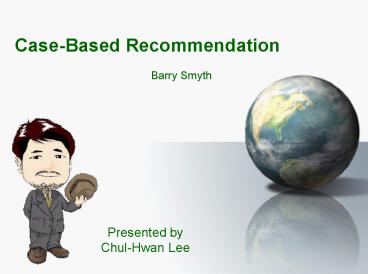CaseBased Recommendation - PowerPoint PPT Presentation
Title:
CaseBased Recommendation
Description:
Preference-based feedback, ratings-based feedback, critiquing-based feedback ... by questionnaires, user ratings or usage traces, asking the user to weight a ... – PowerPoint PPT presentation
Number of Views:45
Avg rating:3.0/5.0
Title: CaseBased Recommendation
1
Case-Based Recommendation
Barry Smyth
- Presented by
- Chul-Hwan Lee
2
Agenda
3
Origins of Case-Based Recommendation
Case-based Reasoning(CBR) A model of reasoning
that incorporates problem solving,
understanding, and learning, and integrates all
of them with memory processes. lt- Soft
Computing Methodology, Cognitive Science CBR
prototype samples Cyrus, Mediator, Persuader,
Chef, Julia, Casey, and Protos,
CLAVIER Case-based Recommendation A form of
content-based recommendation that is especially
well suited to many product recommendation
Domains. Case-base -gt Well-structured Concepts
Description Content-base -gt Less Structured
Textual Item Description
4
Origins of Case-Based Recommendation
Case A contextualized piece of knowledge
representing an experience that teaches a lesson
fundamental to achieving the goals of the
system. Case-based System Operates through a
process of remembering one or a small set of
concrete instances or cases and basing decisions
on comparisons between the new and old
situations. medical diagnosis, legal
interpretation Related Disciplines Fuzzy
Logic(FL), Neural Network(NN), Evolutionary
Computing(EC), Probabilistic Reasoning(PR),
Belief Networks, Chaos Theory, Parts of Learning
Theory Successful Tasks Planning, Design,
Diagnosis, Configuration, Classification,
Prediction Successful Domains Manufacturing,
Medical, Help-desks, Sales Support
5
Major Components of a CBR system
6
CBR Cycle
1. Retrieving similar previously experienced
cases whose problem is judged to be similar 2.
Reusing the cases by copying or integrating the
solutions from the cases retrieved 3. Revising
or adapting the solution(s) retrieved in an
attempt to solve the new problem 4. Retaining
the new solution once it has been confirmed or
validated
7
CBR Cycle
8
Major Tasks of CBR
9
Guidelines for the Use of CBR
1. Does the domain have an underlying model? 2.
Are there exceptions and novel cases? 3. Do
cases recur? 4. Is there significant benefit in
adapting past solutions? 5. Are relevant
previous cases obtainable?
10
Advantages of Using CBR
1. Reducing the knowledge acquisition task. 2.
Avoiding repeating mistakes made in the past. 3.
Providing flexibility in knowledge modeling. 4.
Reasoning in domains that have not been fully
understood, defined, or modeled. 5. Making
predictions of the probable success of a
proffered solution. 6. Learning over time. 7.
Reasoning in a domain with a small body of
knowledge. 8. Reasoning with incomplete or
imprecise data and concepts. 9. Avoiding
repeating all the steps that need to be taken to
arrive at a solution. 10. Providing a means of
explanation. 11. Extending to many different
purposes. 12. Extending to a broad range of
domains. 13. Reflecting human reasoning.
11
Case Representation
Content-base Recommendation unstructured or
semi-structured manner, using keyword-based
content analysis techniques Case-based
Recommendation structured representations, using
attribute-value representations techniques fit
into e-commerce domains
Nominal
Numeric
12
Similarity-based Retrieval
Similarity Assumption most similar to the target
problem, more sophisticated similarity metrics
that are based on an explicit mapping of case
features and the availability of specialised
feature-level similarity knowledge.
ttarget query, ccase, wweight
Inverse relative difference (numerical)
- For nominal data
- Simple exact match metric (1 or 0)
- Use domain knowledge
- (similarity tables or similarity trees by
domain knowledge expert)
Single-Shot Recommendation Problem can be
achieved by personalized recommendation through
extended dialog with the user.
13
(No Transcript)
14
Bounded random selection bounded greedy
selection
15
Alternative Diversity-Preserving Approach
Similarity Layers A set of cases, ranked by their
similarity to the target query are partitioned
into similarity layers, such that all cases in a
given layer have the same similarity value to the
query. Order-based Retrival constructs an
ordering relation from the query provided by the
user and applies this relation to the case-base
of products returning the k items at the top of
the ordering. Compromise-driven Approach the most
similar cases to the users query are often not
representative of compromises that the user may
be prepared to accept.
16
Navigation by Asking
Employing Natural Language Processing(NLP),
originated from conversational case-based
reasoning systems.
An example conversational dialog between a user
(the inquirer) and the Adaptive Place Advisor
recommender system (the advisor) in which the
user is trying to decide on a restaurant for
dinner
17
Navigation by Proposing
Preference-based feedback, ratings-based
feedback, critiquing-based feedback(dynamic
compound critiques)
Entree recommends restaurants to users and
solicits feedback in the form of feature
critiques. The screenshot a recommendation for
Planet Hollywood along with a variety of fixed
critiques (less, nicer, cuisine etc.) over
features such as the price, ambiance and cuisine
of the restaurant.
18
A screenshot of the digital camera recommender
system evaluated in which solicits feedback in
the form of fixed unit critiques and a set of
dynamically generated compound critiques. The
former are indicated on either side of
the individual camera features, while the latter
are presented beneath the main product recommendat
ion as a set of 3 alternatives.
19
User Modeling
Users personal preference Users learned
preference Weak personalization to Strong
personalization Long term user preference
information This can be achieved by
questionnaires, user ratings or usage traces,
asking the user to weight a variety of areas of
interest, normal online behavior
patterns Case-based Profiling Profiling Feature
Preferences
20
Towards to Hybrid Recommendation System, Better
System! Explain the results of their
reasoning Justify their recommendations In/With
Product Space Final Goal is to provide good
system to the world! Thats why we are here!
1 Pal, S. Shiu, S. Foundations of Soft
Case-Based Reasoning, Wiley Series on Intelligent
System, 2004. 2 Smyth, B. Cotter, P. A
personalized Television Listing Service,
Communications of the ACM, 2000, 107-111. 3
Goker, M. Thompson, C. Personalized
Conversational Case-Based Recommendation, Journal
of Artificial Intelligence Research, 2004,
1-36. 4 Ricci, F., Cavada, D., Mirzadeh, N.,
Venturini, A. Case-Based Travel Recommendations,
2005, Retrieved from http//ectrl.itc.it8080/home
/publications/2005/cbr-cabv3.pdf on Sep. 2005.
21
Question or Comments?
http//www.sis.pitt.edu/chlee chlee56_at_pitt.edu































